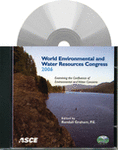Hydrologic Monitoring Criteria for Freshwater Wetland Plant and Animal Communities
Publication: World Environmental and Water Resource Congress 2006: Examining the Confluence of Environmental and Water Concerns
Abstract
Wetland hydrologic studies often occur because of concern for a wetland's plant and animal communities, which are controlled by relatively small fluctuations in water levels on these generally low relief landscapes. Hydrologic monitoring is typically designed to address two primary questions. What are the natural hydrologic processes operating at a site? How have they been altered by human activities? We address these questions primarily by installing monitoring wells on transects to document water table fluctuations above and below the ground surface. These transects are established along the primary hydrologic gradients resulting from natural processes on the site as well as those resulting from human alterations on and around the site. Wells along the transects are installed in multiple examples of each of the major plant communities to document the relative degree of human influence within each major type of plant community and in different parts of the site. In areas with a high groundwater table, the wells are normally open between about 6 and 12 ft below the ground surface to document the relationship of the water table to the site's vegetative characteristics. They are typically hand-driven because of the inaccessibility of most of our monitoring sites. Since they are driven into the ground and we are usually working in environments that burn frequently, we use galvanized steel pipe. Most of the monitoring has been done periodically (weekly-to-monthly) by hand because of limited funds and the remoteness of the well locations, although we try to have a few continuous water level recorders located somewhere on or near our study sites. We plan on a minimum of three years monitoring, and are usually able to extend this period of record by developing correlations with other nearby hydrologic or climatologic stations. Since the longer the period of record, the more valuable the data becomes, we try to initiate some level of hydrologic monitoring as soon as possible, particularly on sites where we have long term management responsibilities.
Get full access to this chapter
View all available purchase options and get full access to this chapter.
Information & Authors
Information
Published In
Copyright
© 2006 American Society of Civil Engineers.
History
Published online: Apr 26, 2012
ASCE Technical Topics:
- Animals
- Business management
- Ecosystems
- Environmental engineering
- Fresh water
- Groundwater
- Human and behavioral factors
- Hydrologic engineering
- Hydrology
- Practice and Profession
- River engineering
- River systems
- Water (by type)
- Water and water resources
- Water level
- Water management
- Water supply
- Water table
- Wells (water)
- Wetlands (fresh water)
Authors
Metrics & Citations
Metrics
Citations
Download citation
If you have the appropriate software installed, you can download article citation data to the citation manager of your choice. Simply select your manager software from the list below and click Download.
